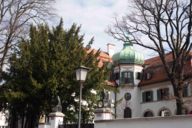
“Monacensia” – a poetic name for the city’s literary archive. It translates roughly as “pieces of Munich”, and there isn’t a word that could better describe the uniqueness of this institution. What a vibrant, splendid and internationally respected place!
The Monacensia in the Hildebrandhaus is much more than just a city library or literary archive. The magnificent villa on the banks of the Isar – with its turrets, creaking wooden spiral staircases, and high and bright rooms – preserves the legacy of Munich’s authors like Thomas Mann and Frank Wedekind, as well as Munich’s actors like Therese Giehse. This is where creative minds and experts stand before large audiences to discuss art and literature and read passages from their new books.
A priceless treasure can be found right on the ground floor: Oskar Maria Graf’s desk with retractable typewriter from his exile in New York. The wood is full of notes containing German addresses, while black-and-white postcards hang to one side with pictures of Lake Starnberg and people in traditional Bavarian dress. This shows how much the writer must have yearned for his home after being exiled by the Nazis. The suicide note of Lena Christ, who took her own life with cyanide, is exhibited nearby. And a menu shows how the city of Munich celebrated the winner of the later Nobel Prize for Literature, Thomas Mann, at the town hall in 1919 – with crab tails, bird’s nest soup and cheese sticks.
The basement is used to store valuable pieces at 14 degrees on heavy moving shelves, including numerous original documents with handwritten notes from the authors and actors, the complete legacies of these creative minds and even surprising things like the gloves of the writer and amateur goalkeeper Albert Ostermaier. When you hold these documents in your hand, you’re taken back to another era and begin to understand the historical and personal context in which the world-famous works were created.
The villa’s double doors are open to anyone who’s interested: Coffee drinkers who just want to read in peace in the glazed extension, “Café Mon”; students who’d like to see handwritten pieces; authors and writers in the making; and all tourists who’d like to find out even more about Munich while chatting in the wonderfully bright café. It’s not unusual to have a conversation with a local author in the middle of their work.
They are the ones who take centre stage at the Monacensia. After all, the “Library of the Mann Family” is joined by the “Library of Munich Authors”, which is dedicated to the city’s writers. Whenever someone from Munich puts a book on the market, they can place it on the shelves of this library for three years, and keen visitors can browse and borrow their works. The works of famous authors like Hans Pleschinski (“Königsallee”) stand alongside those of journalists like Veronika Beer and Stefanie Gentner, who like to publish something creative once in a while (“Glücksorte in München”).
The Monacensia is the literary memory of Munich. The city’s works couldn’t be presented in a more beautiful setting than the Hildebrandhaus of 1898, which is a piece of art and history itself. The tower room has painted lemons on the ceiling and offers a magnificent view of the city. This used to be the family home of the sculptor Adolf von Hildebrand, who created the Wittelsbach Fountain on Lenbachplatz and the Father Rhine Fountain at the Deutsches Museum. These fantastic fountain sculptures were made at his artist’s villa behind the huge gates to his studio, before being transported through the city by horse and cart to their current sites. While the villa is now home to old and new books, the charm of the Wilhelminian era has certainly remained.